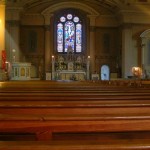Liturgical Celebrations (Second Week of Advent: 5 Dec.-11 Dec. 2004)
This is the second week of Advent and the Feast of the Immaculate Conception on Wed. (8 Dec.) is very appropriate as a preparation for Christmas. This Feast was made a Holyday of Obligation in 1708.
Monday (6/12/04): St. Nicholas Bishop of Myra (4th century): Myra is in south-western Turkey. Like some popular saints, there is hardly any strictly historical information about him. The whole tradition of Santa Claus in modern times is based on the folklore about him.
Tuesday (7/12/04): St. Ambrose (339-397): He was governor of Milan, a very important civil position when the Bishop of Milan died in 374. Ambrose wasn’t even baptised at that time but only was a catechumen preparing to enter the Church. At the meeting to elect a new bishop, a voice, said to be that of a child, kept shouting “Ambrose for bishop”. To his complete surprise, the whole crowd took up the slogan and although he tried his best to stress his unsuitability, he had no choice but to accept the position. Within a week he was baptised and consecrated Bishop. He sold all his belongings and gave the money for charity. As Bishop he did great work in organizing the diocese, protecting the Christian faith against various kinds of heresies prevalent at the time and writing very valuable theological books about important issues of the Christian faith. He also had an important share in the conversion of Augustine, another of the great Christian leaders of the early Church.
Wed. (8/12/04): The Immaculate Conception of BVM. This means that Mary by a singular grace was kept free from all stain of original sin from the moment of her conception. The doctrine was solemnly defined by Pope Pius IX on 8th Dec. 1854. Mary revealed herself to Bernadette Soubirous in Lourdes in 1858 as: “I am the Immaculate Conception”. Mary is the new Eve and her feast is particularly appropriate in the preparation for Christmas.
Thursday (9/12/04): St. Juan Diego Cuauhtlatoatzin (1474-1548). Juan Diego was a native Indian. The name “Cuauhtlatoatzin” was the name he was given when he was born – it meant “the talking eagle” in his native language. He became a convert and was still under instruction when he had the vision. On his way to morning Mass on 9th Dec. 1531 he had a vision of Our Lady at Tepeyak, a hill north-west of Mexico city. She instructed him to ask the Bishop (Juan de Zumárraga) to build a Church on that site. The Bishop was sceptical about his story. Three days later she appeared to Juan Diego again and asked him to climb the hill and pick flowers that he would find in bloom. He obeyed and although it was winter time and the ground frozen, he found roses flowering. Our Lady asked him to take them to the Bishop as proof. He put them in his mantle and brought them to the Bishop. When he opened his mantle in front of the Bishop, the roses fell to the ground. What was more significant was that there was an image of his vision of Our Lady imprinted on his mantle. This image (Our Lady of Guadalupe) can still be seen on the mantle today in the Basilica at the hillsite at Tepeyak. The first foreign visit that Pope John Paul II made was to this site and he went there again for the beatification of Juan Diego (6 May 1990) and for his canonization (31 July 2002). He praised his humility – Juan Diego said to Mary: “I am a nobody. I am a small rope, a tiny ladder, the tail end, a leaf.”
Sat. (11/12/04): St. Damasus: He was born around 304 and was Pope, (Damasus 1), from 366 to 384. He defended the Church’s teaching against Arianism and other heresies. He also insisted on the primacy of the Pope as successor of Peter and freedom from the domination of the Emperor in Constantinople. He commissioned St. Jerome to translate the Bible into Latin and this became known as the “Vulgate” and was accepted as official by the Church.
Liturgical Celebrations (Second Week of Advent: 13 Dec.-18 Dec. 2004)
Monday (13/12/04): St. Lucy (martyred 304): She died in Syracuse in the persecution of the emperor Dioclesion. Devotion to her goes back to the early Church and she is mentioned in the Roman Canon of saints. She is said to have been a wealthy Sicilian who refused marriage offers and gave her money to the poor. It is said that various attempts to kill her were made and she was finally killed by the sword. Like many popular saints, so many stories have been made up about her down through history that it is hard to find stricly historical details. In Venice, in a Church near the railway station, there is a partially incorrup body which is claimed to be hers. There is a popular song dedicated to her: “Santa Lucia”. She is also greatly honoured in Sweeden where her feastday (13 Dec.) used to be the shortest day of the year or the winter-solstice. This was before the reform of the Greagorian Calendar in 1582 when 10 days were dropped from the calendar – a reform that wasn’t accepted in Sweeden until 1753:
Santa Lucia, thy light is glowing
Through darkest winter night, comfort bestowing.
Dreams float on dreams tonight,
Comes then the morning light,
Santa Lucia, Santa Lucia.
Tuesday (14/12/04): St. John of the Cross (1542-1591): A Carmelite friar and virtual founder of the Discalced Carmelites. He was also one of Spain’s foremost poets and mystical theologians. He first thought of joining the Carthusian Order but was persuaded by Theresa of Avila to work for the reform of the Carmelite Order. Because of opposition to his work he was imprisoned and he wrote some of his finest poetry why he was in prison. He weas canonized in 1726 and declared a doctor of the Church in 1926.
17-24 Dec. 2004: These days are especially dedicated to the celebration of Christmas.




